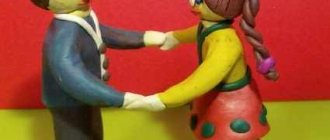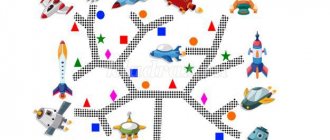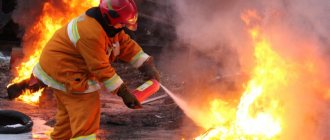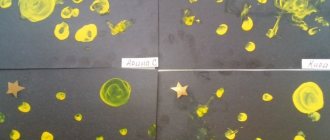Notes on non-traditional drawing for older children. Theme: Space
Notebook on non-traditional drawing on the topic “Travel to Space” for children of the senior preschool group
Author: Salova Elena Viktorovna, teacher, MBDOU - kindergarten No. 7, Yekaterinburg Description: this summary on non-traditional drawing is intended for pupils of senior preschool groups. It will be of interest to educators, additional education teachers and parents. The goal is to create conditions for the development of children's creative abilities through non-traditional drawing. Objectives: Educational objectives:
– introduce unconventional drawing – drawing with napkins;
– consolidate knowledge about space. Developmental tasks:
– to develop the ability to work with non-traditional tools;
– develop children's creative abilities. Educational objectives:
– to cultivate an aesthetic attitude towards planet Earth and space as a whole;
– to cultivate sensitivity to the perception of the beauty of the surrounding world. Planned result: – be able to apply acquired knowledge; – be able to listen carefully and answer questions; - be able to complete assigned tasks. Form of joint activity: gaming, communicative. Form of organization: collective. Integration of educational areas: “Artistic and aesthetic development”, “Cognitive development”, “Speech development”, “Social and communicative development”. Educational and methodological set: Tools: – visual
– illustrations of the Solar system, the view of the Sun and Earth from space;
– equipment
– magnetic board;
– materials and tools
– gouache, paper napkins, album sheets.
Progress of the lesson
Updating children's knowledge
The teacher attracts the attention of children. Educator. Guys, today we are going on a trip with you! But not in a simple way, but in a cosmic way! What should we take with us? Children's answers. Educator. Great! We have collected our things, now we need to get dressed. What do astronauts wear? Children's answers. Educator. That's right, you need to put on a spacesuit. He will protect us and also give us air, because there is no air in space, and a person cannot live without it. Now we have to get on the bike and fly. Right? /no/
Why can’t we ride a bicycle to space?
Children's answers. Educator. Of course, a bicycle cannot fly. And you can only get to space using special transport. What is it called? /rocket/
We are boarding a rocket! Our journey begins!
Finger gymnastics
1,2,3,4,5
(Children take turns bending the fingers of one hand, starting with the little finger, helping with the index finger of the other hand).
We will fly in space
(Children rotate the hand, which is clenched into a fist)
.
1 – comet. 2 – planet. 3 – lunar rover. 4 – starship. 5 – earth (Children take turns extending their fingers, starting with the thumb)
.
Goodbye friends! (Children wave their hands, as if saying goodbye)
.
Same with the other hand.
Communicative activity
Educator. Guys, look, we are already flying in space! Oh, our porthole is dusty with cosmic dust, let's wipe it down. Children make circular movements with their hands. The teacher places an illustration of the solar system on the board.
Educator. Guys, look how far we have flown. What do we see? Children's answers. Educator. That's right, this is the solar system. At its center is the Sun star, and the planets revolve around it. Who knows what planets are in the solar system? Children's answers. The teacher summarizes the children's answers. Educator. Let's fly a little closer to our Sun? The teacher places an illustration of the Sun on the board - a view in space.
Educator. Look how beautiful and interesting the Sun is when you look at it from space! How would you describe it? Children's answers. Educator. Great, but you and I have flown far from the Earth, I’m afraid we won’t have enough fuel, let’s fly a little closer to the Earth and look at it. The teacher places an illustration of the Earth on the board - a view from space.
Educator. Guys, this is planet Earth! Do you like this look? What is the Earth like, how would you describe it? Children's answers.
Creating a problem situation
Educator. Our Earth is very beautiful! Let's take a picture of her and show our parents what we saw today! Oh, who took the camera? What do we do? How do we capture such beauty? Children's guesses. Educator. That's right, guys!
You can draw the Earth and show it to your parents! Great, but first we'll stretch our legs and arms a little. Motor activity
Children stand in a circle and run after each other.
Fast rockets are waiting for us to fly to the planets.
Whichever one we want, we’ll fly to that one! But there is one secret in the game: (Children squat down)
There is no room for latecomers!
Repeat several times.
Visual activities
Educator. Well done boys! Only we have a small problem again! I took paints on our trip, but forgot about the brushes! But I have one idea! You and I will draw with napkins! Our space is extraordinary and our drawings will be extraordinary too! The teacher explains the progress of the work. Educator. In front of you lies a landscape sheet with the outline of the Earth, a palette and napkins. Educator. Take one piece of napkin and crumple it into a ball. Let's dip it in blue paint and stamp the ocean, but the most important thing is not to smear it, but to print it.
Educator. Next, take another napkin, crumple it too, dip it in brown paint - these are mountains and dry land.
Educator. Next, we print the meadows, forests and fields with green paint.
Educator. The earth is ready. Now we will paint space with purple paint.
Educator. The final touch is to paint distant stars and planets with yellow paint.
Reflection
Educator. Guys, did you like the time we spent with you today? What did you like most? What new did you learn today? Let's take a look at our wonderful works!
We recommend watching:
Unconventional drawing technique Blotography. Master class How to draw a cosmic landscape step by step Drawing with crayons on paper for children from 4 years old Drawing using the TRIZ system in the senior group on the topic: Space
Similar articles:
Drawing autumn leaves, grades 1-2
Preview:
Summary of a drawing lesson in the senior group
"Journey into Space"
— To develop the ability to correctly convey the location of rocket parts.
— Cultivate accuracy in work, perseverance, and the ability to complete the work started.
I call the children to me and ask:
— What kind of transport do you think can be used to fly to other planets? (on a rocket, spaceship)
— Why does the rocket have a sharp tip near the body? (So that the rocket can fly faster, the sharp tip cuts through the air)
Showing the way to depict a rocket
— First I draw the rectangular body of the rocket. He's quite large. The rocket can fly in any direction you want. Then I triangular tip and triangular wings. Then we draw round portholes. Remember that the rocket body and windows must be different colors so that they do not merge.
In space through the thickness of years
(They clench and unclench their fingers.)
An icy flying object.
(Raise a clenched fist, tilt it left and right.)
And the object's name is comet.
(They clench and unclench their fingers.)
When children work independently, if necessary, we use an individual display on our sheet. I use passive actions.
Then I create an exhibition of children’s work.
On the topic: methodological developments, presentations and notes
“Outer space” (lesson summary on visual arts.
An educational activity using an unconventional drawing technique.
An integrated summary of direct educational activities in drawing and speech development on the topic: “Space travel.” Senior group.
1. Strengthen children’s ability to draw using the “stroke” method with a gel pen, using a quick sketch with a “T” graphite pencil in a tone drawing.
Summary of a drawing lesson using the scratching method “Space Landscape” Danilova Irina Nikolaevna Summary of a drawing lesson using the scratching method “Space Landscape” Lesson objectives.
Preview:
State budgetary preschool educational institution
Child development center-kindergarten No. 60
Krasnoselsky district of St. Petersburg
Continuous educational activities for the artistic and aesthetic development of children
Tikhonenko Anna Anatolyevna
Modern educational technologies:
Technology of developmental education:
Continue to introduce children to the holiday - Cosmonautics Day.
— strengthen children’s ability to draw a rocket flying in space.
- develop cognitive activity in children.
- develop children's sensory abilities.
- to develop the ability to operate with ideas and transform them on the basis of accumulated knowledge, experience and imagination to create independent visual works of a creative nature, to introduce initiative into the design, content, and form of what is depicted.
— improve drawing skills.
- develop aesthetic perception, memory, attention, speech.
- reading poems about space, asking riddles, looking at illustrations about astronauts, planets, drawing space using non-traditional techniques
sheets of black paper for each child in A4 format, gouache paints, brushes, jars of water, napkins, illustrations about space and astronauts, hoops of different colors for outdoor games, headbands.
Arrived in a flock of stars.
The teacher shows illustrations of different rockets and spaceships.
Children board a pre-built rocket made from soft modules.
Educator: Guess the riddle.
A man sits in a rocket.
He flies boldly into the sky,
And at us in his spacesuit
He's looking from space.
Cosmonauts wear special clothes - a spacesuit. (showing illustrations) Look how durable it is!
Let's put on our spacesuits and go flying! (children put on headbands, close their eyes to the music and imagine flying.)
Educator: guys, we are in outer space, tell me what you see? (children's answers) Distant planets seem to us like luminous stars, look at the planets that scientists have photographed. (showing illustrations of the planets of the solar system) And now we’ll play!
Outdoor game “Fast rockets are waiting for us”
Rocket hoops are laid out across the group. There are several fewer of them than there are players. Children hold hands and walk in a circle saying:
— Fast rockets are waiting for us.
For flight to planets.
But there is one secret in the game:
There is no room for latecomers!
After the last words, the children scatter and take places in the “rockets” (if there are many children, then two or three people can sit in one rocket) and take different space poses. Those who did not get a place in the rocket choose the most interesting and beautiful poses of the astronauts. Then everyone stands in a circle again and the game starts all over again.
Educator: Guys, we played with you, and now we will draw a rocket that flies into space. (showing ways to draw a rocket, children draw)
Educator: Now we’ll rest a little.
Physical school
— Cosmonauts need a special space suit - a spacesuit. It protects the human body and allows you to breathe. We are also in space now and we are wearing spacesuits.
On the topic: methodological developments, presentations and notes
Mathematics lesson for the senior group.
In the “Understanding the World” classes, they get acquainted with the Universe, learn what the solar system consists of, about human flight into space, etc. This summary and presentation will help teachers and kindergarten teachers.
In a lesson using a surprise moment, children get acquainted with a map of the solar system. An interesting experience is carried out, an outdoor game, and most interestingly, a productive activity using non.
Summary of an integrated lesson in the senior group." Space pioneers."
Summary of a speech therapy lesson in the senior/preparatory group on the topic “Space”. Goals: to introduce children to the topic “Space”. Objectives: correctional and educational: to teach children to select words with the same root.
Today, space flights have become completely commonplace for the inhabitants of the Earth. It is believed that the exploration of other planets is not far off. But the beginning of this was laid by our Russian cosmonaut. American.
Lesson notes for the senior group Theme “Space”.
Source





